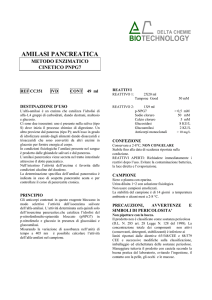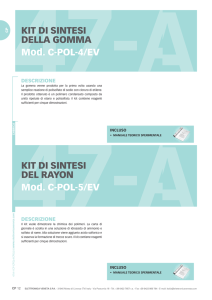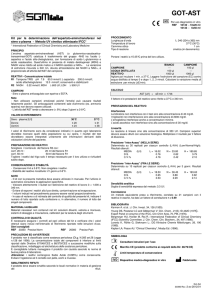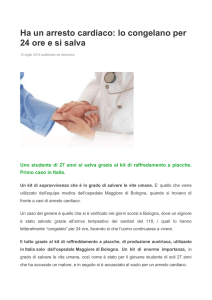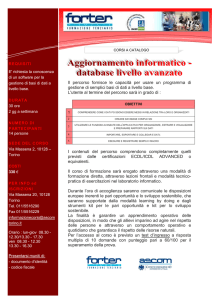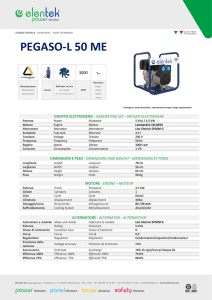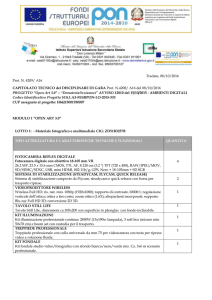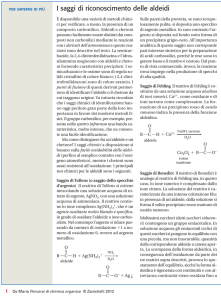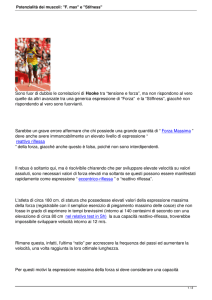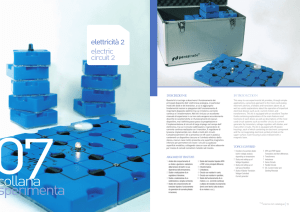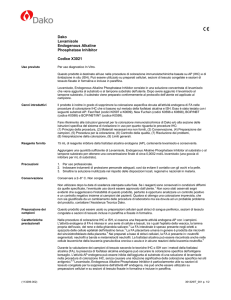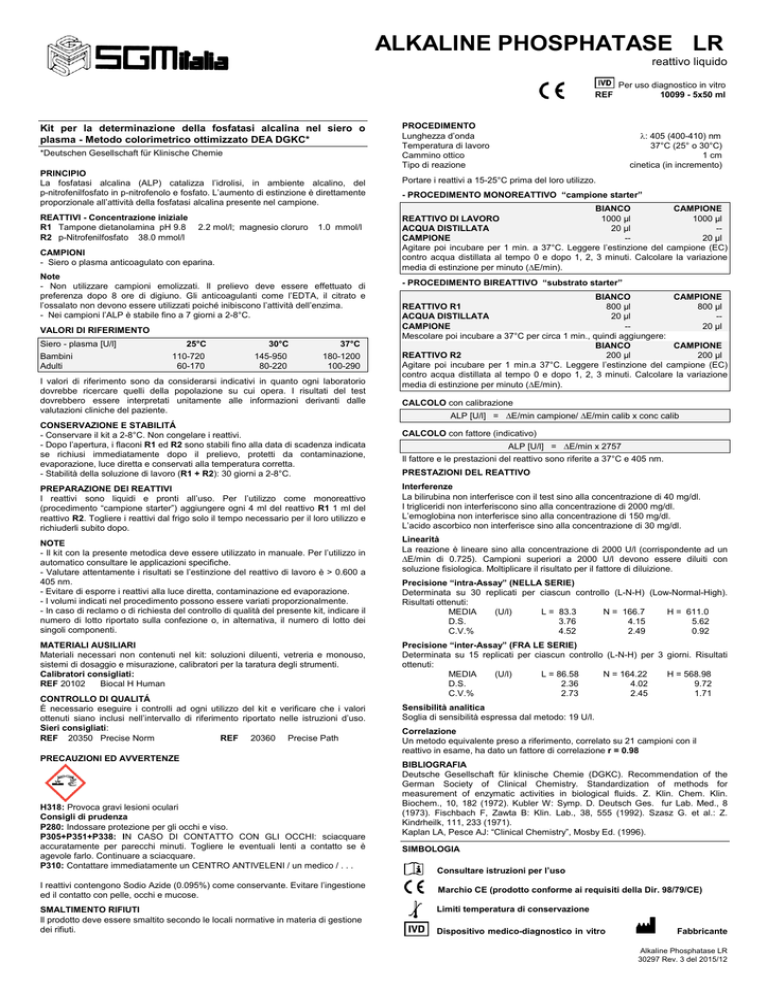
ALKALINE PHOSPHATASE LR
reattivo liquido
REF
Kit per la determinazione della fosfatasi alcalina nel siero o
plasma - Metodo colorimetrico ottimizzato DEA DGKC*
*Deutschen Gesellschaft für Klinische Chemie
PRINCIPIO
La fosfatasi alcalina (ALP) catalizza l’idrolisi, in ambiente alcalino, del
p-nitrofenilfosfato in p-nitrofenolo e fosfato. L’aumento di estinzione è direttamente
proporzionale all’attività della fosfatasi alcalina presente nel campione.
REATTIVI - Concentrazione iniziale
R1 Tampone dietanolamina pH 9.8
R2 p-Nitrofenilfosfato 38.0 mmol/l
2.2 mol/l; magnesio cloruro
1.0 mmol/l
CAMPIONI
- Siero o plasma anticoagulato con eparina.
Note
- Non utilizzare campioni emolizzati. Il prelievo deve essere effettuato di
preferenza dopo 8 ore di digiuno. Gli anticoagulanti come l’EDTA, il citrato e
l’ossalato non devono essere utilizzati poiché inibiscono l’attività dell’enzima.
- Nei campioni l’ALP è stabile fino a 7 giorni a 2-8°C.
VALORI DI RIFERIMENTO
Siero - plasma [U/l]
Bambini
Adulti
25°C
110-720
60-170
30°C
145-950
80-220
37°C
180-1200
100-290
I valori di riferimento sono da considerarsi indicativi in quanto ogni laboratorio
dovrebbe ricercare quelli della popolazione su cui opera. I risultati del test
dovrebbero essere interpretati unitamente alle informazioni derivanti dalle
valutazioni cliniche del paziente.
CONSERVAZIONE E STABILITÁ
- Conservare il kit a 2-8°C. Non congelare i reattivi.
- Dopo l’apertura, i flaconi R1 ed R2 sono stabili fino alla data di scadenza indicata
se richiusi immediatamente dopo il prelievo, protetti da contaminazione,
evaporazione, luce diretta e conservati alla temperatura corretta.
- Stabilità della soluzione di lavoro (R1 + R2): 30 giorni a 2-8°C.
Per uso diagnostico in vitro
10099 - 5x50 ml
PROCEDIMENTO
Lunghezza d’onda
Temperatura di lavoro
Cammino ottico
Tipo di reazione
: 405 (400-410) nm
37°C (25° o 30°C)
1 cm
cinetica (in incremento)
Portare i reattivi a 15-25°C prima del loro utilizzo.
- PROCEDIMENTO MONOREATTIVO “campione starter”
BIANCO
CAMPIONE
REATTIVO DI LAVORO
1000 µl
1000 µl
ACQUA DISTILLATA
20 µl
-CAMPIONE
-20 µl
Agitare poi incubare per 1 min. a 37°C. Leggere l’estinzione del campione (EC)
contro acqua distillata al tempo 0 e dopo 1, 2, 3 minuti. Calcolare la variazione
media di estinzione per minuto (E/min).
- PROCEDIMENTO BIREATTIVO “substrato starter”
BIANCO
CAMPIONE
REATTIVO R1
800 µl
800 µl
ACQUA DISTILLATA
20 µl
-CAMPIONE
-20 µl
Mescolare poi incubare a 37°C per circa 1 min., quindi aggiungere:
BIANCO
CAMPIONE
REATTIVO R2
200 µl
200 µl
Agitare poi incubare per 1 min.a 37°C. Leggere l’estinzione del campione (EC)
contro acqua distillata al tempo 0 e dopo 1, 2, 3 minuti. Calcolare la variazione
media di estinzione per minuto (E/min).
CALCOLO con calibrazione
ALP [U/l] = E/min campione/ E/min calib x conc calib
CALCOLO con fattore (indicativo)
ALP [U/l] = E/min x 2757
Il fattore e le prestazioni del reattivo sono riferite a 37°C e 405 nm.
PRESTAZIONI DEL REATTIVO
PREPARAZIONE DEI REATTIVI
I reattivi sono liquidi e pronti all’uso. Per l’utilizzo come monoreattivo
(procedimento “campione starter”) aggiungere ogni 4 ml del reattivo R1 1 ml del
reattivo R2. Togliere i reattivi dal frigo solo il tempo necessario per il loro utilizzo e
richiuderli subito dopo.
Interferenze
La bilirubina non interferisce con il test sino alla concentrazione di 40 mg/dl.
I trigliceridi non interferiscono sino alla concentrazione di 2000 mg/dl.
L’emoglobina non interferisce sino alla concentrazione di 150 mg/dl.
L’acido ascorbico non interferisce sino alla concentrazione di 30 mg/dl.
NOTE
- Il kit con la presente metodica deve essere utilizzato in manuale. Per l’utilizzo in
automatico consultare le applicazioni specifiche.
- Valutare attentamente i risultati se l’estinzione del reattivo di lavoro è > 0.600 a
405 nm.
- Evitare di esporre i reattivi alla luce diretta, contaminazione ed evaporazione.
- I volumi indicati nel procedimento possono essere variati proporzionalmente.
- In caso di reclamo o di richiesta del controllo di qualità del presente kit, indicare il
numero di lotto riportato sulla confezione o, in alternativa, il numero di lotto dei
singoli componenti.
Linearità
La reazione è lineare sino alla concentrazione di 2000 U/l (corrispondente ad un
E/min di 0.725). Campioni superiori a 2000 U/l devono essere diluiti con
soluzione fisiologica. Moltiplicare il risultato per il fattore di diluizione.
MATERIALI AUSILIARI
Materiali necessari non contenuti nel kit: soluzioni diluenti, vetreria e monouso,
sistemi di dosaggio e misurazione, calibratori per la taratura degli strumenti.
Calibratori consigliati:
REF 20102
Biocal H Human
Precisione “inter-Assay” (FRA LE SERIE)
Determinata su 15 replicati per ciascun controllo (L-N-H) per 3 giorni. Risultati
ottenuti:
MEDIA
(U/l)
L = 86.58
N = 164.22
H = 568.98
D.S.
2.36
4.02
9.72
C.V.%
2.73
2.45
1.71
CONTROLLO DI QUALITÁ
É necessario eseguire i controlli ad ogni utilizzo del kit e verificare che i valori
ottenuti siano inclusi nell’intervallo di riferimento riportato nelle istruzioni d’uso.
Sieri consigliati:
REF 20350 Precise Norm
REF 20360 Precise Path
PRECAUZIONI ED AVVERTENZE
H318: Provoca gravi lesioni oculari
Consigli di prudenza
P280: Indossare protezione per gli occhi e viso.
P305+P351+P338: IN CASO DI CONTATTO CON GLI OCCHI: sciacquare
accuratamente per parecchi minuti. Togliere le eventuali lenti a contatto se è
agevole farlo. Continuare a sciacquare.
P310: Contattare immediatamente un CENTRO ANTIVELENI / un medico / . . .
I reattivi contengono Sodio Azide (0.095%) come conservante. Evitare l’ingestione
ed il contatto con pelle, occhi e mucose.
SMALTIMENTO RIFIUTI
Il prodotto deve essere smaltito secondo le locali normative in materia di gestione
dei rifiuti.
Precisione “intra-Assay” (NELLA SERIE)
Determinata su 30 replicati per ciascun controllo (L-N-H) (Low-Normal-High).
Risultati ottenuti:
MEDIA
(U/l)
L = 83.3
N = 166.7
H = 611.0
D.S.
3.76
4.15
5.62
C.V.%
4.52
2.49
0.92
Sensibilità analitica
Soglia di sensibilità espressa dal metodo: 19 U/l.
Correlazione
Un metodo equivalente preso a riferimento, correlato su 21 campioni con il
reattivo in esame, ha dato un fattore di correlazione r = 0.98
BIBLIOGRAFIA
Deutsche Gesellschaft für klinische Chemie (DGKC). Recommendation of the
German Society of Clinical Chemistry. Standardization of methods for
measurement of enzymatic activities in biological fluids. Z. Klin. Chem. Klin.
Biochem., 10, 182 (1972). Kubler W: Symp. D. Deutsch Ges. fur Lab. Med., 8
(1973). Fischbach F, Zawta B: Klin. Lab., 38, 555 (1992). Szasz G. et al.: Z.
Kindrheilk, 111, 233 (1971).
Kaplan LA, Pesce AJ: “Clinical Chemistry”, Mosby Ed. (1996).
SIMBOLOGIA
Consultare istruzioni per l’uso
Marchio CE (prodotto conforme ai requisiti della Dir. 98/79/CE)
Limiti temperatura di conservazione
Dispositivo medico-diagnostico in vitro
Fabbricante
Alkaline Phosphatase LR
30297 Rev. 3 del 2015/12
ALKALINE PHOSPHATASE LR
liquid reagent
REF
Kit for measurement of alkaline phosphatase in serum or plasma
Colorimetric optimized method DEA DGKC*
*Deutschen Gesellschaft für Klinische Chemie
PRINCIPLE
Alkaline phosphatase (ALP) catalyzes the hydrolysis, in alkaline environment, of
p-nitrophenylphosphate into p-nitrophenol and phosphate. The absorbance
increasing is directly proportional to the alkaline phosphatase activity in the
sample.
REAGENTS
R1 Diethanolamine buffer pH 9.8 2.2 mol/l; magnesium chloride
R2 P-nitrophenylphosphate 38.0 mmol/l
1.0 mmol/l
SAMPLE
- Serum or heparinized plasma.
: 405 (400-410) nm
37°C (25° o 30°C)
1 cm
kinetic (increasing)
Bring the reagents at 15-25°C before using them.
- MONOREAGENT PROCEDURE “sample starter”
BLANK
SAMPLE
WORKING REAGENT
1000 µl
1000 µl
DISTILLED WATER
20 µl
-SAMPLE
-20 µl
Mix, then incubate for 1’ a 37°C. Measure the absorbance of sample (EC) against
distilled water decrease per minute during 3 minutes. Calculate the average
absorbance difference per minute (E/min).
- BIREAGENT PROCEDURE “substrate starter”
Note
- Do not use samples with haemolysis. The withdrawal must be made, preferably,
after 8 hours of fasting. The anticoagulants as EDTA, citrate and oxalate must not
be used because they inhibit the enzyme activity.
- The ALP is stable in the samples up to 7 days at 2-8°C.
REFERENCE VALUES
Serum - plasma [U/l]
Children
Adults
PROCEDURE
Wavelength
Working temperature
Optical path
Reaction
For in vitro medical device
10099 - 5x50 ml
25°C
110-720
60-170
30°C
145-950
80-220
37°C
180-1200
100-290
References values are considered indicatives since each laboratory should
establish references ranges for its own patient’s population. The analytical results
should be evaluated with other information coming from patient’s clinical story.
STORAGE AND STABILITY
- Store the kit at 2-8°C. Do not freeze the reagents.
- After opening, the vials R1 and R2 are stable up to the expiry date if recapped
immediately and protected from contamination, evaporation, direct light, and
stored at the correct temperature.
- Working solution stability (R1+ R2): 30 days at 2-8°C.
PREPARATION OF REAGENTS
Reagents are liquid and ready to use. About using as monoreagent (samplestarter procedure) add to every 4 ml of R1 reagent, 1 ml of R2 reagent. Keep out
the reagents from refrigerator only for the use and recap them immediately.
NOTE
- The kit, according to this method, must be used in manual procedures. About
automatic using follow specific applications.
- Evaluate carefully the results if working reagent absorbance is 0.600 at
405 nm.
- Avoid direct light, contamination and evaporation.
- The volumes in the procedure can be changed proportionally.
- In case of complaint or quality control request, refer to the lot number on the
package or the lot number on the singles vials.
AUXILIARY EQUIPMENT
Materials not included in the kit: diluent solutions, laboratory glassware,
disposable tips, photometers and calibrators.
Suggested calibrator:
REF 20102 Biocal H Human
QUALITY CONTROLS
It’s necessary, every time the kit is used, to make the quality controls and to check
that values obtained are within the acceptance range provided in the insert.
Suggested serum:
REF 20350 Precise Norm
REF 20360 Precise Path
PRECAUTION IN USE
H318: Causes serious eye damage.
P280: Wear eye protection/ face protection.
P305 + P351 + P338: IF IN EYES: Rinse cautiously with water for several
minutes. Remove contact lenses, if present and easy to do. Continue rinsing.
P310: Immediately call a POISON CENTER or doctor/physician.
The reagents contain Sodium Azide (0.095%) as preservative. Avoid swallowing
and contacting with skin, eyes and mucous membranes.
BLANK
SAMPLE
REAGENT R1
800 µl
800 µl
DISTILLED WATER
20 µl
-SAMPLE
-20 µl
Mix, incubate at 37°C for 1’ and then add:
REAGENT R2
200 µl
200 µl
Mix, then incubate for 1’ a 37°C. Measure the absorbance of sample (EC) against
distilled water decrease per minute during 3 minutes. Calculate the average
absorbance difference per minute (E/min).
CALCULATION with calibration
ALP [U/l] = E/min sample/ E/min calib x conc calib
CALCULATION with factor (indicative)
ALP [U/l] = E/min x 2757
The factor and the reagent performances are related to 37°C and 405 nm.
ANALYTICAL PERFORMANCES
Interferences
Bilirubin does not interfere up to concentration of 40 mg/dl.
Triglycerides do not interfere up to concentration of 2000 mg/dl.
Hemoglobin does not interfere up to concentration of 150 mg/dl.
Ascorbate acid does not interfere up to concentration of 30 mg/dl.
Linearity
Reaction is linear up to a concentration of 2000 U/l (corresponding to E/min of
0.725). Samples with values exceeding 2000 U/l must be diluted with saline
solution. Multiply, then, the result for diluting factor.
“Intra-Assay” precision (within-Run)
Determined on 30 samples for each control (L-N-H) (Low-Normal-High).
Results:
MEAN
(U/l)
L = 83.3
N = 166.7
H = 611.0
S.D.
3.76
4.15
5.62
C.V.%
4.52
2.49
0.92
“Inter-Assay” precision (between-run)
Determined on 15 samples for each control (L-N-H) for 3 days.
Results:
MEAN
(U/l)
L = 86.58
N = 164.22
S.D.
2.36
4.02
C.V.%
2.73
2.45
H = 568.98
9.72
1.71
Analytical sensitivity
The test sensitivity in terms of detection limit is 19 U/l.
Correlation
A study based comparing this method with a similar method on 21 samples has
given a correlating factor r = 0.98
BIBLIOGRAPHY
Deutsche Gesellschaft für klinische Chemie (DGKC). Recommendation of the
German Society of Clinical Chemistry. Standardization of methods for
measurement of enzymatic activities in biological fluids. Z. Klin. Chem. Klin.
Biochem., 10, 182 (1972). Kubler W: Symp. D. Deutsch Ges. fur Lab. Med., 8
(1973). Fischbach F, Zawta B: Klin. Lab., 38, 555 (1992). Szasz G. et al.: Z.
Kindrheilk, 111, 233 (1971).
Kaplan LA, Pesce AJ: “Clinical Chemistry”, Mosby Ed. (1996).
SYMBOLS
Read instruction for use
CE mark (requirement of 98/79 regulation)
Storaging temperature limits
WASTE MANAGEMENT
Please refer to the local legal requirements.
In vitro medical device
Producer
Alkaline Phosphatase LR
30297 Rev. 3 del 2015/12

